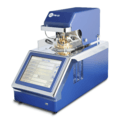Flash point facts for kids
The flash point is a special temperature for liquids that can easily turn into a gas, like gasoline or alcohol. Imagine a liquid giving off invisible fumes. The flash point is the lowest temperature at which these fumes will catch fire if a spark or flame is nearby. It's like the "ignition temperature" for the vapors, not the liquid itself.
It's easy to mix up the flash point with other terms. The autoignition temperature is when a substance catches fire all by itself, without any spark or flame. The fire point is a bit different too. It's the lowest temperature where the vapors keep burning for at least five seconds after you remove the flame. The fire point is usually a bit higher than the flash point. This is because at the flash point, there might not be enough vapor to keep the fire going once the spark is gone.
What are Flash Points Used For?
The flash point helps us understand how dangerous different fuels are. It helps us tell the difference between fuels that are very easy to burn, called flammable fuels, and those that are harder to burn, called combustible fuels.
For example, gasoline (petrol) is a flammable fuel because its flash point is very low. This means its vapors can catch fire easily, even at cold temperatures. Diesel fuel, on the other hand, is a combustible fuel. Its flash point is higher, so it's not as easy for its vapors to catch fire.
In many places, fuels with a flash point below 37.8 degrees Celsius (about 100 degrees Fahrenheit) are called flammable. Fuels with a flash point above that temperature are called combustible. This helps people know how to store and handle different liquids safely to prevent fires.
How is Flash Point Measured?
Scientists and engineers around the world need to measure flash points in the same way. This is why several groups work together to create rules and standards for how to do it. Some of the main groups include the CEN / ISO Joint Working Group on Flash Point (JWG-FP) and the ASTM D02.8B Flammability Section.
These standards explain exactly what equipment to use, what steps to follow, and how accurate the test results should be. This makes sure that when someone measures a flash point in one country, the results can be understood and trusted by people in another country.
Images for kids
See also
 In Spanish: Punto de inflamabilidad para niños
In Spanish: Punto de inflamabilidad para niños



